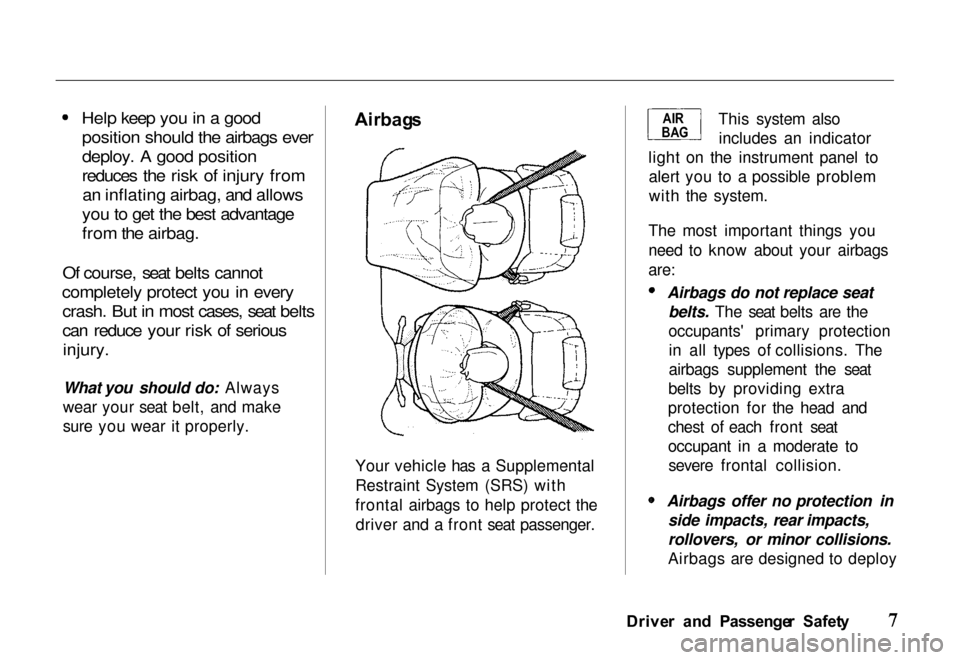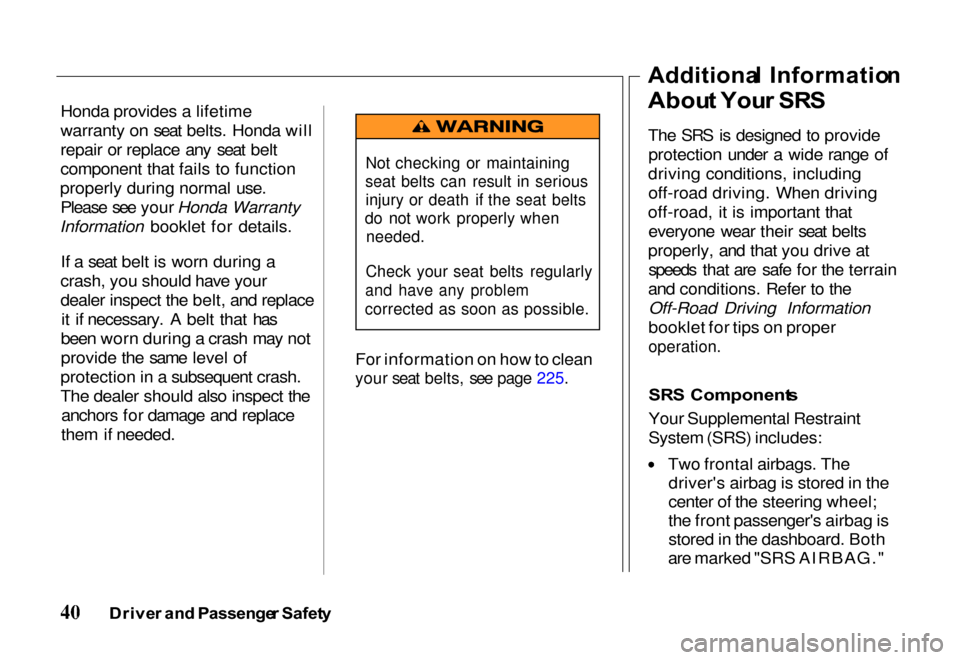Page 10 of 267

Help keep you in a good
position should the airbags ever
deploy. A good position
reduces the risk of injury froman inflating airbag, and allows
you to get the best advantage
from the airbag.
Of course, seat belts cannot
completely protect you in every crash. But in most cases, seat belts
can reduce your risk of seriousinjury.
What you should do: Always
wear your seat belt, and make
sure you wear it properly. Airbag
s
Your vehicle has a Supplemental
Restraint System (SRS) with
frontal airbags to help protect the driver and a front seat passenger. This system also
includes an indicator
light on the instrument panel to alert you to a possible problem
with the system.
The most important things you
need to know about your airbags
are: Airbags do not replace seat
belts. The seat belts are the
occupants' primary protectionin all types of collisions. The
airbags supplement the seat
belts by providing extra
protection for the head and
chest of each front seat
occupant in a moderate to severe frontal collision. Airbags offer no protection in
side impacts, rear impacts,
rollovers, or minor collisions.
Airbags are designed to deploy
Drive r an d Passenge r Safet y
AI
R
BA G
Page 11 of 267

only during a moderate to
severe frontal collision.
Airbags can pose serious
hazards. To do their job,airbags must inflate with
tremendous force and speed. So
while airbags save lives, they
can cause serious injuries to
adults and larger children who
are not wearing seat belts, are
not wearing them properly, are sitting too close to the airbag,
or are not sitting in a proper
position. Infants and small
children are at an even greater
risk of injury or death.
What you should do: Always
wear your seat belt properly, and sit upright and as far back as
possible from the steering wheel
or dashboard.
Seat
s an d Seat-Back s
Your vehicle's seats are designed to keep you in a comfortable,
upright position so you can take
full advantage of the protection
offered by seat belts and the energy-absorbing materials in the
seats.
How you adjust your seats and
seat-backs can also affect your
safety. For example, sitting too
close to the steering wheel or
dashboard increases the risk of
you or your passenger being injured by striking the inside of
the vehicle, or by an inflating
airbag.
Reclining a seat-back too far
reduces the seat belt's
effectiveness and increases the
chance that the seat's occupant
will slide under the seat belt in a
crash and be seriously injured.
What you should do: Move the
front seats as far back as possible,
and keep adjustable seat-backs in
an upright position whenever the
vehicle is moving.
Hea d Restraint s
Head restraints can help protect
you from whiplash and other
injuries. For maximum protection,
the back of your head should rest
against the center of the head
restraint.
Drive r an d Passenge r Safet y
Page 19 of 267

7
. Maintai n a Prope r Sittin g
Positio n
After all occupants have adjusted their seats and put on seat belts, itis very important that they
continue to sit upright, well back in their seats, with their feet on
the floor, until the vehicle is
parked and the engine
is off.
Sitting improperly can increase
the chance of injury during a
crash. For example, if an occupant slouches, lies down, turns
sideways, sits forward, leans
forward or sideways, or puts one
or both feet up, the chance of injury during a crash is greatly
increased.
In addition, an occupant who is
out of position in the front seat
can be seriously or fatally injured
by striking interior parts of the vehicle, or by being struck by an
inflating airbag.
Remember, to get the best
protection from your vehicle's airbags and other safety features,
you must sit properly and wear your seat belt properly.
Advic
e fo r Pregnan t Wome n
Because protecting the mother is
the best way to protect her unborn
child, a pregnant woman should
always wear a seat belt whenever she drives or rides in a vehicle.
Drive r an d Passenge r Safet y
Sitting improperly or out of
position can result in serious
injury or death in a crash.
Always sit upright, well back in
the seat, with your feet on the
floor.
Page 43 of 267

Honda provides a lifetime
warranty on seat belts. Honda will
repair or replace any seat belt
component that fails to function
properly during normal use. Please see your Honda Warranty
Information booklet for details.
If a seat belt is worn during a
crash, you should have your
dealer inspect the belt, and replace it if necessary. A belt that has
been worn during a crash may not
provide the same level of
protection in a subsequent crash.
The dealer should also inspect the anchors for damage and replace
them if needed. For information on how to clean
your seat belts, see page 225.
The SRS is designed to provide
protection under a wide range of
driving conditions, including off-road driving. When driving
off-road, it is important that everyone wear their seat belts
properly, and that you drive at speeds that are safe for the terrain
and conditions. Refer to the Off-Road Driving Information
booklet for tips on proper
operation.
SR S Component s
Your Supplemental Restraint
System (SRS) includes:
Two frontal airbags. Thedriver's airbag is stored in the
center of the steering wheel;
the front passenger's airbag is
stored in the dashboard. Both
are marked "SRS AIRBAG."
Drive r an d Passenge r Safet y
Additiona
l Informatio n
Abou t You r SR S
Not checking or maintaining
seat belts can result in serious injury or death if the seat belts
do not work properly when
needed.
Check your seat belts regularly
and have any problem
corrected as soon as possible.
Page 46 of 267

If the light stays on after the
engine starts.
If the light comes on or flashes
on and off while you drive.
If you see any of these
indications, your airbags may not
deploy when you need them. See your Honda dealer as soon as
possible.
SR
S Servic e
Your Supplemental Restraint
System is virtually maintenance-
free, and there are no parts you
can safely service. However, you
must have your vehicle serviced if:
Your airbags ever inflate. The
airbags and control unit must
be replaced. Do not try to
remove or replace the airbags yourself. This must be done by
a Honda dealer or a
knowledgeable body shop.
The SRS indicator light alerts
you to a problem. Take your vehicle to an authorized Honda
dealer as soon as possible. If
you ignore this indication, the
airbags might not inflate when
you need them.
Additiona
l Safet y
Precaution s
Do not attempt to deactivate
your airbags. Together, airbags and seat belts provide the best
protection in a moderate to severe frontal collision.
Do not tamper with SRS components or wiring for any
reason. Tampering could cause
the airbags to deploy, possibly
causing very serious injury.
See page 170 for further information and precautions
relating to your SRS.
Drive r an d Passenge r Safet y
Ignoring the SRS indicator light
can result in serious injury or
death if the airbags do not inflate when needed.
Have your vehicle checked by a
dealer as soon as possible if
the SRS light alerts you to a potential problem.